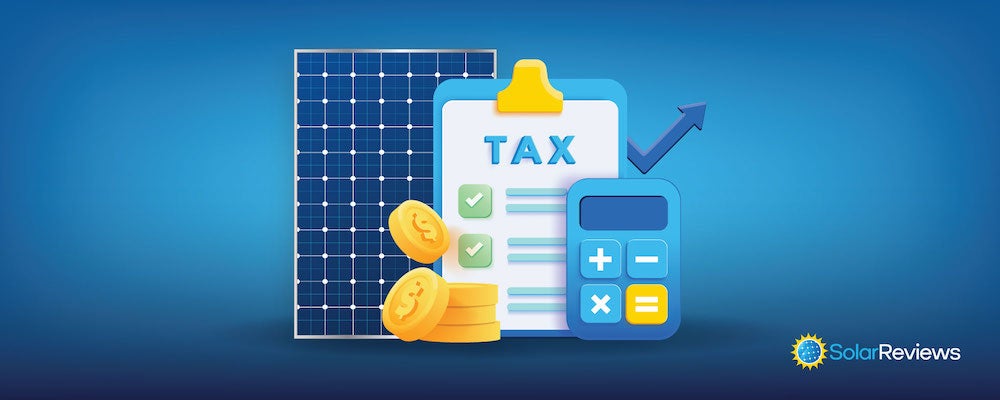
The biggest solar incentive in the United States just got a bit better thanks to the Inflation Reduction Act. Starting in August 2022, the solar tax credit, also called the Residential Clean Energy Credit, homeowners can get a tax credit equal to 30% of the cost to install solar panels.
The solar tax credit can save you thousands of dollars on your taxes in 2023. In some cases, it can even completely eliminate what you owe.
Most Americans are eligible for the solar tax credit, but there are some key factors you need to know about how it works, what qualifies, and who can take advantage of it before you make the switch to solar.
Why you can trust SolarReviews:
SolarReviews is the leading American website for consumer reviews and ratings of residential solar panels and solar panel installation companies. Our industry experts have over two decades of solar experience combined and maintain editorial independence for their reviews. No company can pay to alter the reviews or review scores shown on our site. Learn more about SolarReviews and how we make money.The federal solar tax credit at a glance:
- Solar systems installed before 2033 are eligible for a tax credit equal to 30% of the costs of installing solar panels.
- A $20,000 solar system would receive a tax credit of $6,000 to what you owe in federal income taxes.
- Solar systems installed in 2033 will receive a 26% tax credit, while systems installed in 2034 will get a 22% tax credit before the tax credit expires completely in 2035.
- To qualify for the tax credit, you must own the solar panels, have a taxable income, and it must be installed at your primary or secondary residence.
- Battery storage systems can also receive the 30% federal tax credit when charged exclusively with solar. Starting in 2023, standalone battery installations will also qualify for the credit.
Calculating how much the solar tax credit can save you in 2023
Before we get into the nitty-gritty details, let’s go over the basics of calculating how much money you can save with the solar tax credit.
For 2023, the solar tax credit is worth 30% of your solar installation costs. So, if your solar installation cost $20,000, you would be eligible for a tax credit of $6,000. The tax credit doesn’t directly lower the upfront cost of the installation. Instead, it lowers what you owe in federal income taxes. If you owe $7,000 in taxes and earn that $6,000 tax credit, your tax liability drops to $1,000. Pretty straightforward.
From now until the end of 2032, you can expect to receive the full 30% tax credit. But, the tax credit won’t be around forever. Starting in 2033, the tax credit steps down to 26% of installation costs. Then, in 2034, the credit drops again to 22%. In 2035, the federal solar tax credit will expire altogether for residential systems.
The easiest way to do this is by using our solar tax credit calculator. We estimate how much a solar system will cost for your home, what other incentives you qualify for, and how much you can expect to earn through the federal solar tax credit.
File away! To get the federal tax credit, you need to fill out IRS Form 5695. The process is pretty straightforward, but we’ve created a step-by-step guide to help you file for the tax credit and answer all of the questions you might have about the process. Make sure to consult with a tax advisor before filing.
What if my tax credit is worth more than what I owe?
The solar tax credit is non-refundable, meaning if your credit is worth more than what you owe in taxes, you’re not going to get any sort of check or refund for it. But, that doesn’t mean you won’t get the full value of it. Any leftover value will carry over and be applied to your taxes the next year.
So, let’s say you install solar panels and get a $6,000 tax credit, but you only owe $4,000 in federal income taxes. That leaves you with $2,000 of your tax credit that will be applied to next year's taxes. The tax credit can be carried forward for a maximum of 5 years.
How to qualify for the 30% federal solar tax credit in 2023
As we said earlier, most Americans will qualify for the federal tax credit. But, there are some cases where you might not be eligible. The eligibility requirements are as follows:
- You must be the owner of the solar panel system.
- You must have a taxable income.
- The solar system must be installed at your primary or secondary residence.
- It must be claimed on the original installation of the project.
Owning your solar system: If you go solar using a solar lease or a solar PPA, you cannot claim the federal solar tax credit because you are not the owner of the solar system. If you purchase solar using a solar loan, you can still take advantage of the tax credit because you are the owner of the system.
What costs qualify for the federal solar tax credit?
Most, if not all, of the costs associated with installing solar panels are eligible to be covered by the federal solar tax credit. Qualified costs include:
- Equipment: The cost of the solar panels, racking, wiring, and inverters.
- Contractor labor: The cost of labor associated with site preparation, installation, and planning, as well as the cost of any permitting fees and inspections.
- Sales tax: Any sales tax associated with the above costs is also covered by the tax credit.
Technically, the tax credit isn't just for solar installations. Other clean energy systems can also get the tax credit, including solar water heaters, fuel cell systems, geothermal heat pumps, and even small wind energy systems!
Are battery storage systems eligible for the federal solar tax credit?
Yes, energy storage is covered by the 30% tax credit. Thanks to the passage of the Inflation Reduction Act, battery systems paired with solar panels in 2023 can get the full 30% credit. The batteries don’t even need to be connected to solar panels to qualify!
On average, residential batteries cost between $10,000 and $15,000 to install, so you can expect to receive a tax credit between $3,000 and $4,500 for energy storage. If the battery is installed with solar panels, the battery costs will be bundled with the rest of your solar installation costs.
To receive the tax credit, batteries must be at least 3 kilowatt-hours in size. Most home storage batteries are around 10 kWh in size, so you likely won't have to worry about the minimum capacity requirement.
How does the solar tax credit work with state, local, and utility incentives?
The federal tax credit isn't the only incentive available to homeowners who switch to solar. You could be eligible for other incentives offered by your state government, or even your utility company. The type of incentive could potentially impact how much your federal solar tax credit will be worth.
Utility incentives
In most cases, if you’re getting a rebate from your utility company, the value of the utility rebate will be subtracted from your total costs before the federal tax credit is calculated. This reduces the value of your tax credit.
Here’s an example: you install a solar system for $20,000 and you get a $1,000 rebate from your utility company. Instead of the tax credit being based on the initial $20,000 cost, it would instead be based on the price after subtracting the utility rebate. In this case, that’s $19,000.
You can use the following formula to calculate how much your tax credit will be worth after a utility incentive:
30% x (Total system cost - Utility rebate amount) = Federal tax credit value
State solar tax credits and incentives
Unlike utility incentives, state government incentives usually don’t need to be deducted before the federal tax credit is calculated.
So, if you installed a $20,000 system and got a $1,000 state government rebate, the solar tax credit would be based on the initial price of $20,000. In this example, that means the tax credit would be worth 30% of $20,000, for a federal tax credit worth $6,000. That would mean you would get a total of $7,000 in incentives.
The same goes for state tax incentives. But, getting a state tax credit will end up increasing your taxable income on your federal tax returns, as you will have fewer state income taxes to deduct. Currently, ten states offer state tax credits, including Arizona, Massachusetts, and New Mexico.
The best time to claim the solar tax credit is now
You have about 10 years to take advantage of the full 30% tax credit. But just because you can wait 10 years doesn’t mean you should. It’s almost always a good idea to make an investment sooner rather than later. installing solar as soon as possible lets you start saving money earlier, so you can stop paying high electricity bills and start putting your money towards the things that really matter to you.
Not to mention, going solar will never be a better investment than it is right now. Other solar incentives throughout the country could expire well before the federal tax credit. Take net metering, the incentive that pays you the full price of electricity for the solar energy you send to the grid, for example. Utilities across the country are moving away from net metering and paying solar customers less money for solar electricity.
You’ll want to install solar before things like net metering and utility rebates start to disappear to guarantee that you get the best solar savings possible. Use our solar panel savings calculator to see what kind of incentives are available in your area, so you can start saving on your electricity bills. Don’t let the sun set on maximum savings!
